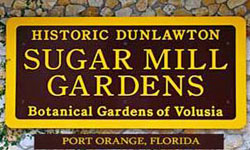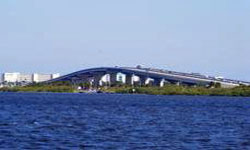|
|
Port Orange
 has a rich history that beings in ancient times with the Seminole and Timucuan Indians. By the mid-1700s, the area was full of explorers, and in 1768, Dr. Andrew Turnbull established his New Smyrna Colony. In 1804, a Mr. Patrick Dean was granted 995 acres from the Spanish Crown, which was later named the Dunlawton Plantation. The Dunlawton Sugar Mill, which dates to the first half of the 1800s, still stands today on Old Sugar Mill Road. It was destroyed twice during the Second Seminole Indian War of 1836 and rebuilt. This was the first wave of settlement in the Port Orange area. has a rich history that beings in ancient times with the Seminole and Timucuan Indians. By the mid-1700s, the area was full of explorers, and in 1768, Dr. Andrew Turnbull established his New Smyrna Colony. In 1804, a Mr. Patrick Dean was granted 995 acres from the Spanish Crown, which was later named the Dunlawton Plantation. The Dunlawton Sugar Mill, which dates to the first half of the 1800s, still stands today on Old Sugar Mill Road. It was destroyed twice during the Second Seminole Indian War of 1836 and rebuilt. This was the first wave of settlement in the Port Orange area.
The second major wave of settlement for what became Port Orange happened after the Civil War. Dr. John Milton Hawks, an abolitionist and U.S. Army surgeon, formed the Florida Land and Lumber Company, along with several other Union Army officers. In 1866, they recruited 500 freed slaves to work the lands along the Halifax River, north of Spruce Creek. Dr. Hawks is credited with naming the settlement Orange Port. In February 1867, Dr. Hawks moved the settlement from Mosquito Inlet (Ponce Inlet) to where the community lies today. In April, 1867, the little town on the banks of the Halifax River was renamed Port Orange because there was already another town in the United States named Orange Port. Unfortunately, due to poor planning and unproductive harvests, only approximately nine families remained in Port Orange by 1869. Even so, they did not give up, but slowly grew into a prosperous community. Thus, this is why they became known as a city “planned by choice, not by chance.” Today, Port Orange is made up of 150 “distinct” neighborhoods. The city’s African-American roots remained, as well, and the area known unofficially as “Freemanville,” in the 1800s is located around the intersection of Orange Avenue and Charles Street. The Mt. Moriah Baptist Church, built in 1911, to this day provides a place of worship to the descendants of those original settlers.
 The Port Orange Causeway, or Port Orange Bridge, which is a four-lane bridge that spans the Halifax River and Intracoastal Waterway, was built in 1990. The Florida State Legislature named the bridge the Congressman William V. Chappel Jr. Memorial Bridge. This is actually the third bridge in the area. The first one at this location was built by the Port Orange Bridge Company in 1906 of palm pilings and pine bridge timbers. It was severely damaged by a hurricane in 1932. Port Orange was without a bridge for several years after that. Then, in 1951, a wooden bascule, two-lane drawbridge was built and paid for with tolls. The Port Orange Causeway, or Port Orange Bridge, which is a four-lane bridge that spans the Halifax River and Intracoastal Waterway, was built in 1990. The Florida State Legislature named the bridge the Congressman William V. Chappel Jr. Memorial Bridge. This is actually the third bridge in the area. The first one at this location was built by the Port Orange Bridge Company in 1906 of palm pilings and pine bridge timbers. It was severely damaged by a hurricane in 1932. Port Orange was without a bridge for several years after that. Then, in 1951, a wooden bascule, two-lane drawbridge was built and paid for with tolls.
|
|
|